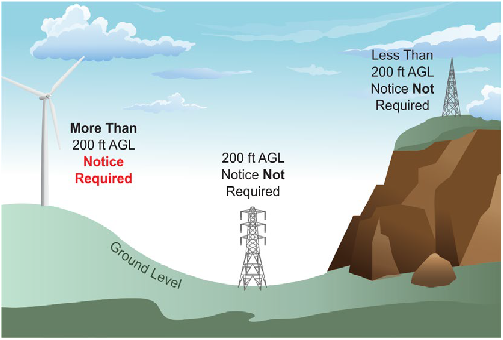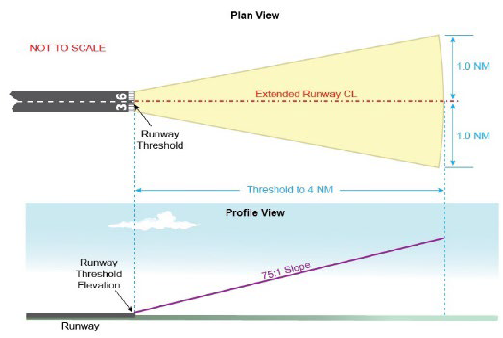Section 2. Notices
- Requirements for notifying the FAA of proposed construction or alteration are contained in contained in 14 CFR § 77.9 (see FIG 5-2-1, FIG 5-2-2, FIG 5-2-3, FIG 5-2-4, and FIG 5-2-5).
- No notice is required, as specified in 14 CFR § 77.9(e), for certain equipment installations “of a type approved by the Administrator" when the equipment is installed in accordance with the established FAA siting criteria. Equipment installed in compliance with the siting criteria without waivers and which do not affect other runways do not have to be considered under 14 CFR part 77 criteria.
- Examples of equipment not requiring notice are:
- Wind equipment (AWOS, ASOS, etc.). Supplemental wind cones, wind turbines, and meteorological towers are not exempt from notice.
- Runway Visual Range (RVR) equipment.
- Instrument Landing Systems (ILS). Includes localizer, glide slope, approach lighting system, distance measuring equipment, outer and inner marker beacons.
- Visual Glide Slope Indicators (VGSI).
- Runway and Taxiway Lights and Signs.
- Runway End Identifier Lighting (REILS).
NOTE-
Construction related equipment (for example, cranes) and activities are not exempt from notice.
- OEG personnel must administer aeronautical studies with the coordinated assistance of Airports, Technical Operations, Spectrum Engineering Services-Frequency Management (FM), Flight Standards, IFP Service Providers, DoD, and Department of Homeland Security representatives.
- The OEG must process notices received under the provisions of of § 44718 and 14 CFR part 77 as OE cases. The exception to this is notices received under those provisions that pertain to structures located on a public-use airport which must be processed by the Airports Division as a nonrulemaking airport (NRA) case (defined in Part 3, Airport Airspace Analysis, of this order).
- If notice is required by any other FAA regulation, the appropriate division must process the notice under that regulation.
Electronic FAA forms are established for use in conducting aeronautical studies. These forms include:
- FAA Form 7460-1, Notice of Proposed Construction or Alteration (OE notice).
- FAA Form 7460-2, Notice of Actual Construction or Alteration (Supplemental Notice).
NOTE-
The electronic system to collect notice(s) of proposed construction or alteration and actual construction is available online at https://oeaaa.faa.gov.
NOTICE REQUIREMENT RELATED TO 200 FEET IN HEIGHT
Notice of Construction or Alteration
§ 77.9(a) - Any construction or alteration that is more than 200 feet AGL at its site.


|
NOTE: |
|
§ 77.9(b) - Any construction or alteration that exceeds an imaginary surface extending outward and upward at any of the following slopes: |
|
§ 77.9(d) - Any construction or alteration on any of the following airports and heliports: |

Subpart B - Notice of Construction or Alteration
§ 77.9(b) - Any construction or alteration that exceeds an imaginary surface extending outward and upward at any one of the following slopes:
(1) 25:1 for a horizontal distance of 5,000 feet from the nearest point of the nearest landing and takeoff area of each heliport described in paragraph d of this section.

Subpart B - Notice of Construction or Alteration
§ 77.9 - Construction or alteration requiring notice. (c) Any highway, railroad, or other traverse way for mobile objects, of a height which, if adjusted upward 17 feet for an Interstate Highway that is part of the National System of Military and Interstate Highways where overcrossings are designed for a minimum of 17 feet vertical distance, 15 feet for any other public roadway, 10 feet or the height of the highest mobile object that would normally traverse the road, whichever is greater, for a private road, 23 feet for a railroad, and for a waterway or any other traverse way not previously mentioned, an amount equal to the height of the highest mobile object that would normally traverse it, would exceed a standard of paragraph (a) or (b) of this section.
NOTICE REQUIREMENT RELATED TO AIRPORT INSTRUMENT APPROACH AREA
Notice of Construction or Alteration

FIG 5-2-6
NOTICE REQUIREMENT RELATED TO AIRPORT PROTECTION ZONE

FIG 5-2-7
NOTICE REQUIREMENT RELATED TO VGSI PROTECTION SURFACE

FIG 5-2-8
NOTICE REQUIREMENT RELATED TO ENROUTE NAV/COM PROTECTION SURFACE

FIG 5-2-9
NOTICE REQUIREMENT RELATED TO SURVEILLANCE PROTECTION SURFACE
